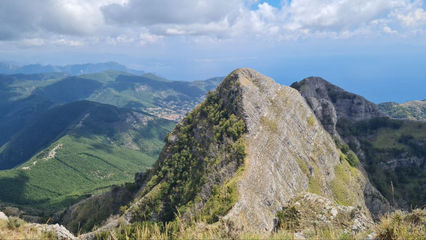Monte San Michele
An ascent, recommended for expert hikers, which leads to the highest peak in the Province (1444 m) from which a 360 degree view of Campania opens up, after a path rich in geological, botanical and historical values.
• Length: About 5.5 Km
• Travel time: 3 h 30 m
• Start point: via Locoli, Pianillo
Information on values and points of interest
The initial part of the route crosses chestnut groves and scrub mixed with deciduous trees, while behind you we have a beautiful view of the Conca di Agerola. Once on the watershed, where it is possible to encounter blooms of wild carnations, the view also opens towards the north, showing us the Conca di Pimonte, the Piana del Sarno and the unmistakable silhouette of Vesuvius. The stretch that climbs along the northern flank of the Tre Pizzi passes over layers of marine limestone from the Cretaceous period and shows a vegetation that is very contrasting with that of the southern side. Instead of holm oaks, beech trees dominate here; some of which are secular. An early medieval legend is linked to the cave of the Holy Water, according to which the devil had settled here, but was driven out by the Archangel St. Michael; with three long leaps the devil overcame the mountains and threw himself into the gulf of Salerno, while the Archangel, in memory of that victory, pierced the rock with his sword and made its spring gush out.
In the seventh century, these peaks saw the hermitages of S. Antonino (now patron saint of Sorrento) and of S. Catello (patron saint of Castellammare di Stabia). Right on top of the Molare they built a small temple dedicated to S. Michele, destroyed by the ravages of the centuries and rebuilt in the twentieth century, on a peak between here and Monte Faito.
Highlight of the excursion are the splendid panoramas that can be enjoyed from the summit reached: below, to the south, we have Positano with its gulf and the islets of Li Galli; to the west, the entire Sorrentine Peninsula and Capri; to the north, the entire Gulf of Naples, with its islands and Vesuvius; to the east, finally, the other peaks of the Lattari Mountains. But if the air is clear, the panorama is much wider and embraces the mountains of Gaeta - Formia up to the southern Cilento (Monte Bulgheria), passing through the blue silhouettes of Matese, Taburno - Camposauro, the mountains of Nola, Avella and Sarno, Monte Picentini and the Alburni and Cervati massifs.
Route information
The path starts from via Locoli, just before the Macello, where there is a small clearing with a trellis. Here you take an uphill path to the right and pass houses and a succession of stables and terraces. Continue to climb along the mule track which, after about 1km, leads to the watershed between Agerola and Pimonte, in the locality of Crocelle (1002m). Here you turn left, following a path between chestnut groves for about 700 m. Near a small crossroads, bordered by a large rock with red signs, turn right. Now go along the north side of Monte S. Angelo in Tre Pizzi, along the "Malo Passo", always keeping to the left and ignoring the small detours that descend from the main mule track. After about 1 km, after passing a stretch bordered by a wooden handrail, the path becomes not very evident on the rocky escarpment; follow the trail markers placed first on the tree trunks and then on the rock. After a short uphill stretch, you enter a wider path and - after about another 200 m - there is a crossroads where you turn left (uphill path under large beech trees). After passing the cave where you can see the source of the Acqua Santa, and continuing on the zigzag steps, you will find a crossroads on the right that leads to the Croce della Conocchia (panoramic western spur of the Tre Pizzi towards which, if desired, it is possible to take a small deviation). Without deviating from the aforementioned crossroads, you come just beyond a characteristic passage between the rocky spiers, which mark the ridge between the north and south sides of the massif. Keeping to the left, you reach the base of the so-called "Molare" (aka Monte S. Michele, the highest peak of the massif), on whose top you can climb a steep flight of steps in rock.







